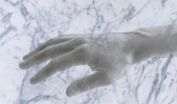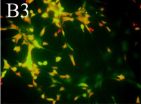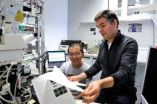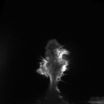(Press-News.org) This news release is available in German.
The study was published in the international scientific journal PLOS ONE on 13 March 2014.
To induce an illusory perception of the material properties of the hand, a group of neuroscientists from Bielefeld University, the Max-Planck Institute for Biological Cybernetics (Germany), and the University of Milano-Bicocca (Italy) asked volunteers to sit with their hands lying on a table in front of them. They repeatedly hit the participants' right hands gently with a small hammer while replacing the natural sound of the hammer against the skin with the sound of a hammer hitting a piece of marble. Within minutes, hands started feeling stiffer, heavier, harder, less sensitive, and unnatural. Moreover, when approached by a threatening stimulus (a needle that the experimenter moved near their hands), participants showed an enhanced Galvanic skin response, thus demonstrating increased physiological arousal.
To perceive our bodies and the world around us, our brains constantly combine information from different senses with prior knowledge retrieved from memory. However, unlike most bodily properties that frequently change over time (such as posture and position), our body material never changes. Hence, in principle, it would be unnecessary for the brain to constantly try to infer it.
This novel bodily illusion, the 'Marble-Hand Illusion', demonstrates that the perceived material of our body, surely the most stable attribute of our bodily self, can quickly be updated through multisensory integration. What is more, it shows that even impact sounds of non-biological materials – such as marble and metal – can be attributed consistently to the body, as if its core material could indeed be modified. This surprising perceptual plasticity might help to explain why tools and prostheses can merge so easily into our body schemas despite being made of non-biological materials.
This multisensory perception study is part of the research being carried out at the Department of Cognitive Neuroscience in the Faculty of Biology. The department is one of 40 research groups that are working at the Center of Excellence Cognitive Interaction Technology (CITEC).
INFORMATION:
Original publication:
Irene Senna, Angelo Maravita, Nadia Bolognini, Cesare V. Parise: The Marble-Hand illusion. PLoS ONE, http://dx.doi.org/10.1371/journal.pone.0091688, published on 12. March 2014.
Would you believe your hand could turn into marble?
Bielefeld neuroscientists present a new bodily illusion
2014-03-24
ELSE PRESS RELEASES FROM THIS DATE:
Hot nanoparticles for cancer treatments
2014-03-24
This news release is available in German. If you put your hand over a switched-on torch in the dark, it appears to glow red. This is because long-wavelength red light beams penetrate human tissue more effectively than short-wavelength blue light. ETH Zurich researchers exploit this fact in a new kind of nanoparticles: so-called plasmonic particles, which heat up when they absorb near-infrared light. This could enable them to kill tumour tissue with heat, for instance.
Gold is a popular material for nanoparticles used therapeutically, as it is well tolerated and ...
Nature Immunology study finds novel population of neutrophils
2014-03-24
Case Western Reserve University researchers have discovered a novel population of neutrophils, which are the body's infection control workhorses. These cells have an enhanced microbial killing ability and are thereby better able to control infection.
Neutrophils, the body's most abundant type of white blood cells, have long been regarded as first responders that kill fungi, bacteria, and other pathogens. In a study published in the February issue of Nature Immunology, Case Western Reserve researchers explain that they have found the mechanism of action of a newly discovered ...
GDNF transfection promotes neuronal differentiation of bone marrow mesenchymal stem cells
2014-03-24
Studies have shown that the differentiation rate of grafted bone marrow mesenchymal stem cells into mature neuron-like cells is very low. Therefore, it is very important to establish an effcient and stable induction protocol to promote the differentiation of bone marrow mesenchymal stem cells into neuron-like cells in vitro and elucidate the mechanisms underlying differentiation for the treatment of central nervous system diseases. Jie Du and colleagues from Sichuan University in China found that glial cell line-derived neurotrophic factor/bone marrow mesenchymal stem cells ...
Electroacupuncture effect on depression and variation of polygenes expression
2014-03-24
Preliminary basic research and clinical findings have demonstrated that electroacupuncture therapy exhibits positive effects in ameliorating depression. However, most studies of the underlying mechanism are at the single gene level; there are few reports regarding the mechanism at the whole-genome level. Using a rat genomic gene-chip, Dr. Dongmei Duan and co-workers from General PLA Hospital in China profiled hippocampal gene expression changes in rats after electroacupuncture therapy. Electroacupuncture therapy alleviated depression-related manifestations in the model ...
Tecnalia presents a smart home able to detect symptoms of neurodegenerative diseases
2014-03-24
The world population is rapidly ageing, which means the number of disabled and dependent people is increasing since these rates increase with age, particularly after the age of 80. This is the context in which the Tecnalia centre for applied research has designed a system of sensors which when fitted in a home, allows a person's habits and activities to be monitored and any changes in his/her habits and activities that could be a symptom of disorders relating to neurodegenerative diseases like Alzheimer's to be detected.
Since the symptoms of diseases like Alzheimer's ...
'MaMTH' advance: New technology sheds light on protein interactions
2014-03-24
TORONTO — Scientists have a better way to study human proteins — large molecules that are part of every cell in the body — thanks to a new technology developed by University of Toronto researchers. The technology tracks a class of proteins called membrane proteins as they interact with other proteins to either maintain health or contribute to disease.
Membrane proteins make up about one third of all proteins in the human body, and their malfunction is associated with more than 500 diseases. But they've been hard to study because understanding their role depends on observing ...
Experiment opens the door to multi-party quantum communication
2014-03-24
In the world of quantum science, Alice and Bob have been talking to one another for years. Charlie joined the conversation a few years ago, but now with spacelike separation, scientists have measured that their communication occurs faster than the speed of light.
For the first time, physicists at the Institute for Quantum Computing (IQC) at the University of Waterloo have demonstrated the distribution of three entangled photons at three different locations (Alice, Bob and Charlie) several hundreds of metres apart, proving quantum nonlocality for more than two entangled ...
Fast and reliable: New mechanism for speedy transmission in basket cells discovered
2014-03-24
This news release is available in German.
In his third major research paper since December 2013, IST Austria Professor Peter Jonas together with his collaborator, postdoc Hua Hu, identifies a new subcellular mechanism for reliable, fast transmission in the so-called basket cells of the brain. The results will be published on the website of Nature Neuroscience on March 23, 2014 (DOI 10.1038/nn.3678)
IST Austria president Thomas Henzinger expressed his delight: "This is an extraordinary streak of publications in major journals which once more emphasizes the outstanding ...
Heparin might be the key to prevent prion conversion and disease
2014-03-24
Prions are infectious agents responsible for neurodegenerative diseases such as bovine spongiform encephalitis (commonly known as "mad cow disease") and Creutzfeldt–Jakob disease in humans.
Since the discovery in the 60s that an incurable and fatal disease could be caused by an infectious agent formed by nothing but converted misfolded proteins, the mechanisms responsible for the conversion of a normal prion protein into its infectious counterpart – the scrapie prion – have been relentlessly investigated. Researchers now know that once converted into the scrapie form, ...
p53 cuts off invading cancer cells
2014-03-24
VIDEO:
In the absence of Omi, Ras-transformed tumor cells form invasive lamellipodial protrusions.
Click here for more information.
The tumor suppressor p53 does all it can to prevent oncogenes from transforming normal cells into tumor cells by killing defective cells or causing them to become inactive. Sometimes oncogenes manage to initiate tumor development in the presence of p53, but, even then, the tumor suppressor doesn't give up and focuses its efforts instead on limiting ...
LAST 30 PRESS RELEASES:
New expert guidance urges caution before surgery for patients with treatment-resistant constipation
Solar hydrogen can now be produced efficiently without the scarce metal platinum
Sleeping in on weekends may help boost teens’ mental health
Study: Teens use cellphones for an hour a day at school
After more than two years of war, Palestinian children are hungry, denied education and “like the living dead”
The untold story of life with Prader-Willi syndrome - according to the siblings who live it
How the parasite that ‘gave up sex’ found more hosts – and why its victory won’t last
When is it time to jump? The boiling frog problem of AI use in physics education
Twitter data reveals partisan divide in understanding why pollen season's getting worse
AI is quick but risky for updating old software
Revolutionizing biosecurity: new multi-omics framework to transform invasive species management
From ancient herb to modern medicine: new review unveils the multi-targeted healing potential of Borago officinalis
Building a global scientific community: Biological Diversity Journal announces dual recruitment of Editorial Board and Youth Editorial Board members
Microbes that break down antibiotics help protect ecosystems under drug pollution
Smart biochar that remembers pollutants offers a new way to clean water and recycle biomass
Rice genes matter more than domestication in shaping plant microbiomes
Ticking time bomb: Some farmers report as many as 70 tick encounters over a 6-month period
Turning garden and crop waste into plastics
Scientists discover ‘platypus galaxies’ in the early universe
Seeing thyroid cancer in a new light: when AI meets label-free imaging in the operating room
Neutrophil-to-lymphocyte ratio may aid risk stratification in depressive disorder
2026 Seismological Society of America Annual Meeting
AI-powered ECG analysis offers promising path for early detection of chronic obstructive pulmonary disease, says Mount Sinai researchers
GIMM uncovers flaws in lab-grown heart cells and paves the way for improved treatments
Cracking the evolutionary code of sleep
Medications could help the aging brain cope with surgery, memory impairment
Back pain linked to worse sleep years later in men over 65, according to study
CDC urges ‘shared decision-making’ on some childhood vaccines; many unclear about what that means
New research finds that an ‘equal treatment’ approach to economic opportunity advertising can backfire
Researchers create shape-shifting, self-navigating microparticles
[Press-News.org] Would you believe your hand could turn into marble?Bielefeld neuroscientists present a new bodily illusion




